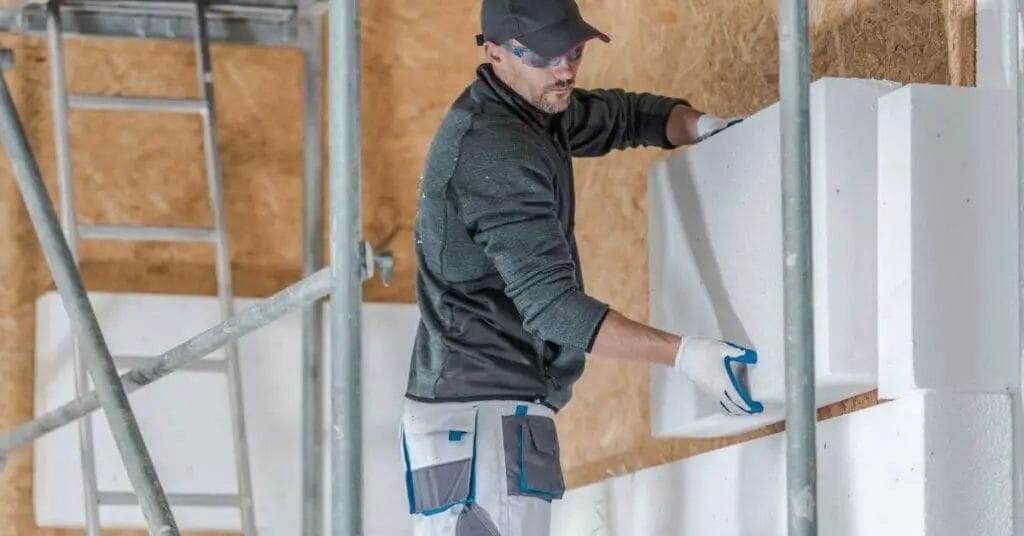In a fast-paced world where you had to deal with a lot of changes and struggles, enjoying some peace and quiet at home is a necessity. But what do you do when the noise outside pervades your sanctuary? Of course, you protect it! Here’s when soundproof insulation comes to the rescue.

Whether it’s the blaring car horns outside, the chatter of your neighbors, or the thumping bass from the next-door party, unwanted noise can be incredibly frustrating.
In this article, we will uncover the secrets behind how soundproof insulation works and how it can transform your living space into a peaceful sanctuary.
Soundproof insulation is not just about blocking out sound; it’s about controlling and absorbing it.
By using materials that have high density and excellent sound absorption properties, soundproof insulation reduces the transmission of noise through walls, floors, and ceilings.
Through a combination of mass, damping, and absorption, soundproof insulation creates a barrier that minimizes the transfer of sound waves, allowing you to enjoy a quieter and more serene environment.
So, if you’re ready to say goodbye to the noise and hello to tranquility, let’s dive into the world of soundproof insulation and discover how it can make a world of difference in your home.

How Soundproof Insulation Works
Soundproof insulation works by employing a combination of techniques to reduce the transmission of sound waves.
The primary goal is to create a barrier that prevents sound from passing through walls, floors, and ceilings.
There are three key factors that contribute to the effectiveness of soundproof insulation: mass, damping, and absorption.
Mass is one of the most important aspects of soundproof insulation. The heavier the material, the better it is at blocking sound.
Mass helps to absorb and reflect sound waves, preventing them from passing through. Materials such as dense fiberglass, mass-loaded vinyl, and gypsum board are commonly used for their high mass characteristics.
Damping is another crucial element in soundproof insulation. It involves reducing the vibrations caused by sound waves.
By damping the vibrations, the energy of the sound waves is dissipated, resulting in a quieter environment.
Damping materials, such as viscoelastic polymers or soundproofing compounds, are applied to surfaces to absorb and dissipate sound energy.
Absorption plays a significant role in soundproof insulation by reducing the reflection of sound waves.
Sound-absorbing materials, such as acoustic foam, mineral wool, or fiberglass, are designed to absorb sound energy and convert it into heat.
This prevents sound waves from bouncing back into the room, resulting in a more acoustically pleasant environment.
By combining these three factors – mass, damping, and absorption – soundproof insulation creates a barrier that effectively blocks, absorbs, and reduces the transmission of sound waves.
This results in a quieter and more peaceful living space where you can finally escape unwanted noise.
Types of Soundproof Insulation Materials
There are various types of soundproof insulation materials available, each with its own unique properties and applications.
Understanding the different options can help you choose the most suitable material for your specific needs.
Fiberglass
Fiberglass is a commonly used soundproof insulation material known for its excellent sound absorption properties.
It is made from fine strands of glass and is available in different forms, such as batts, rolls, or loose-fill. Fiberglass is easy to install and offers good thermal insulation as well.
Mineral Wool
Mineral Wool is another popular choice for soundproof insulation. It is made from natural minerals, such as basalt or slag, and is available in batts or loose-fill form.
Mineral wool is highly effective in absorbing sound and is also fire-resistant, making it a safe option for insulation.
Cellulose
Cellulose is an environmentally friendly option for soundproof insulation. It is made from recycled paper treated with fire retardants and is available in loose-fill form.
Cellulose insulation offers good sound absorption properties and is an excellent choice for reducing airborne noise.
Mass-Loaded Vinyl (MLV)
Mass-Loaded Vinyl (MLV) is a dense and flexible material that is effective in blocking sound. It is commonly used as an additional layer in walls or ceilings to enhance soundproofing.
MLV is easy to install and can be paired with other insulation materials for improved performance.
Acoustic Foam
Acoustic Foam is a specialized soundproof insulation material designed to absorb and reduce sound reflections.
It is commonly used in recording studios, home theaters, and other spaces where sound quality is crucial. Acoustic foam panels come in various shapes and sizes and can be easily installed on walls or ceilings.
Factors to Consider When Choosing Soundproof Insulation
When selecting soundproof insulation for your home, there are several factors to consider to ensure you choose the right material for your specific needs.
- Noise Type: Identify the type of noise you want to block or reduce. Different materials are more effective at reducing specific types of noise, such as airborne noise or impact noise.
- STC Rating: The Sound Transmission Class (STC) rating measures the ability of a material to block sound. Higher STC ratings indicate better soundproofing capabilities. Consider the STC rating of the insulation material to determine its effectiveness in reducing noise.
- Installation Method: Some insulation materials are easier to install than others. Consider whether you will be doing the installation yourself or hiring a professional. Ease of installation can vary depending on the material and the area you want to insulate.
- Budget: Soundproof insulation materials can vary in price. Consider your budget and choose a material that offers the best combination of performance and affordability.
- Space Requirements: Some insulation materials may take up more space than others. Consider the thickness and dimensions of the material to ensure it fits within your existing walls, floors, or ceilings.
- By considering these factors, you can choose the right soundproof insulation material that meets your specific requirements and provides the desired level of noise reduction.
Installing Soundproof Insulation in Walls
Installing soundproof insulation in walls can significantly reduce the transmission of sound between rooms or from outside sources.
While the exact installation process may vary depending on the type of insulation material, there are some general guidelines to follow.
- Prepare the wall: Remove any existing wall coverings, such as wallpaper or paint. Ensure the wall surface is clean and dry before installing the insulation.
- Measure and cut the insulation material: Measure the dimensions of the wall and cut the insulation material to fit. Leave a small gap around the edges to allow for expansion.
- Install the insulation: Place the insulation material against the wall, starting from the bottom and working your way up. Ensure the material fits snugly and covers the entire wall surface.
- Seal gaps and seams: Use acoustic sealant or tape to seal any gaps or seams between the insulation panels. This helps to minimize sound leakage and improve the overall effectiveness of the insulation.
- Reinstall wall coverings: Once the insulation is in place, you can reinstall the wall coverings, such as drywall or panels. Ensure the coverings are securely fastened to prevent any gaps that may compromise the soundproofing.
Installing Soundproof Insulation in Ceilings and Floors
Soundproofing ceilings and floors can be particularly beneficial in reducing airborne noise or impact noise between different levels of a building.
The process of installing soundproof insulation in ceilings and floors is similar to that of walls, with a few additional considerations.
- Prepare the ceiling or floor: Remove any existing flooring or ceiling materials. Ensure the surface is clean and level before installing the insulation.
- Measure and cut the insulation material: Measure the dimensions of the ceiling or floor and cut the insulation material to fit. Leave a small gap around the edges to allow for expansion.
- Install the insulation: Place the insulation material on the ceiling or floor, ensuring it covers the entire surface. Use adhesive or fasteners to secure the insulation in place.
- Seal gaps and seams: Similar to wall insulation, use acoustic sealant or tape to seal any gaps or seams between the insulation panels. This helps to prevent sound leakage and improve the overall soundproofing performance.
- Install new flooring or ceiling materials: Once the insulation is in place, you can install new flooring or ceiling materials. Choose materials that have additional soundproofing properties, such as carpet with a thick underlay or acoustic ceiling tiles.
Benefits of Soundproof Insulation
The benefits of soundproof insulation are numerous and can greatly enhance the comfort and quality of your living space.
Noise Reduction
The primary benefit of soundproof insulation is the significant reduction in unwanted noise.
Whether it’s traffic noise, neighbor’s conversations, or loud appliances, soundproof insulation can create a peaceful and quiet environment where you can relax and enjoy uninterrupted tranquility.
Improved Privacy
Soundproof insulation helps to create a sense of privacy by reducing the transmission of sound between rooms.
This is particularly beneficial in shared living spaces, such as apartments or townhouses, where maintaining privacy is essential.
Enhanced Sleep Quality
A quieter environment promotes better sleep quality. Soundproof insulation can help block out external noise, allowing you to sleep more soundly and wake up feeling refreshed.
Increased Energy Efficiency
Some soundproof insulation materials also offer thermal insulation properties, helping to improve energy efficiency in your home.
By reducing heat transfer, soundproof insulation can contribute to lower energy bills and a more comfortable living environment.
Value Addition
Installing soundproof insulation can increase the value of your property.
Potential buyers or renters appreciate the added comfort and peace of mind that comes with a well-insulated and quiet living space.
Common Misconceptions about Soundproof Insulation
There are several common misconceptions about soundproof insulation that can lead to misunderstandings or unrealistic expectations. Let’s debunk some of these misconceptions.
Soundproofing vs. Sound Absorption
Soundproofing and sound absorption are two different concepts.
Soundproofing aims to block or reduce the transmission of sound, while sound absorption focuses on reducing sound reflections within a room.
Soundproof insulation materials often have sound absorption properties, but it’s important to understand the distinction.
Complete Sound Elimination
While soundproof insulation can significantly reduce noise, it cannot completely eliminate it.
Some low-frequency sounds or vibrations may still be audible, especially if they are transmitted through other pathways, such as windows or doors.
One-Size-Fits-All Solution
Different insulation materials have different properties and are suitable for specific applications.
There is no one-size-fits-all solution for soundproofing.
Consider the specific noise issues you want to address and choose the appropriate insulation material accordingly.
Easy Installation
While some soundproof insulation materials are relatively easy to install, others may require professional expertise.
Complex installations, such as retrofitting existing walls, may necessitate the help of experienced installers to ensure proper performance.
It’s important to have realistic expectations and understand the limitations and capabilities of soundproof insulation to make informed decisions and achieve the desired results.

DIY vs. Professional Installation of Soundproof Insulation
Deciding whether to undertake a DIY installation or hire professionals for soundproof insulation depends on several factors.
Skill and Experience
DIY installation can be a viable option for simple projects or for individuals with basic construction skills.
However, for more complex installations or if you lack experience, hiring professionals can ensure proper installation and optimal performance.
Time and Effort
DIY installation requires time and effort, especially if you are unfamiliar with the process.
Professionals can complete the installation more quickly and efficiently, saving you time and effort.
Guaranteed Results
Hiring professionals ensures that the soundproof insulation is installed correctly, maximizing its performance and effectiveness.
Professionals can also provide warranties or guarantees for their work, giving you peace of mind.
Safety Considerations
Some insulation materials may require special handling or precautions during installation.
Professionals are trained to work with these materials safely, minimizing the risk of accidents or health hazards.
Consider your skills, available time, and the complexity of the installation when deciding between a DIY approach or hiring professionals.
Consulting with experts can help you make an informed decision and achieve the best results.
